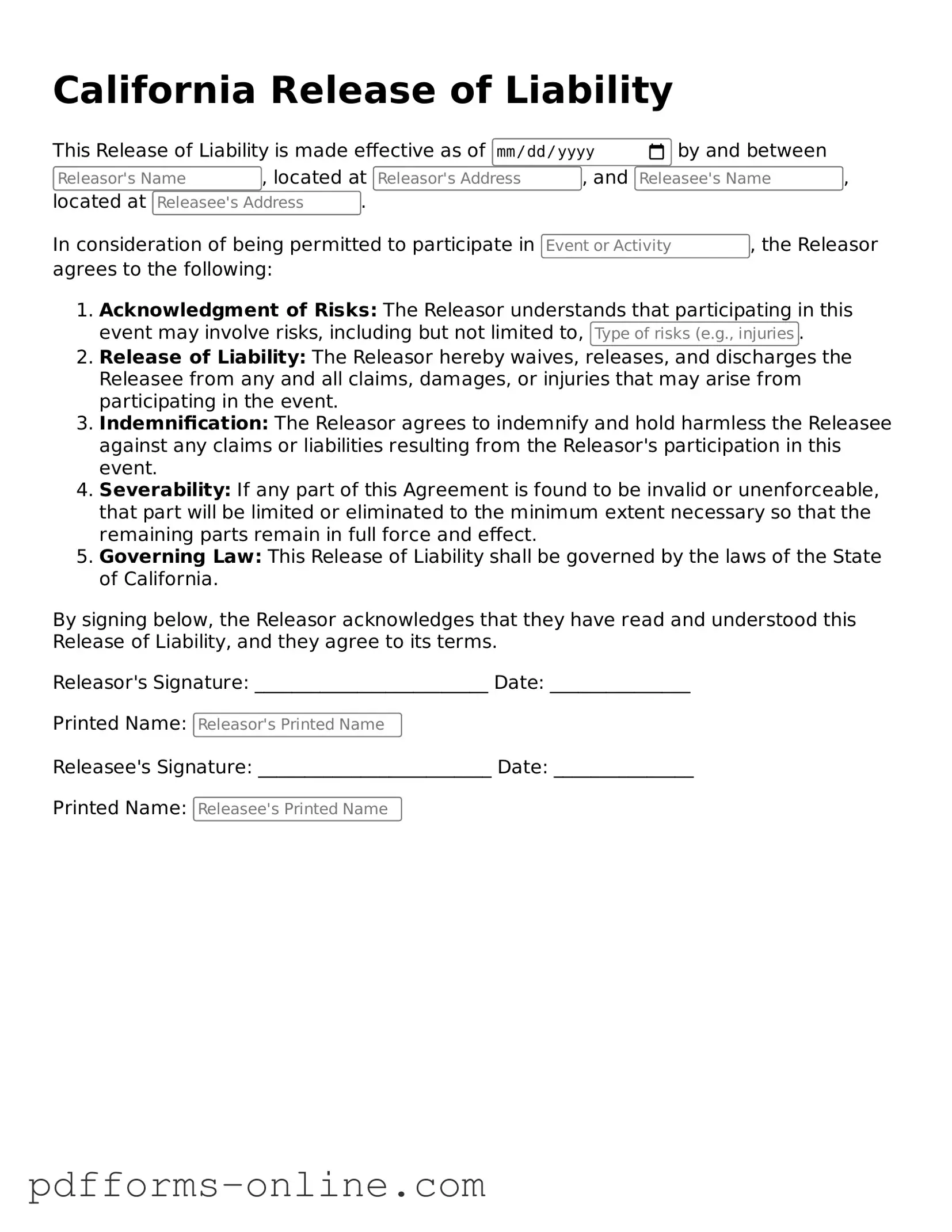The California Release of Liability form shares similarities with the Waiver of Liability form, which is often used in various contexts, such as sports and recreational activities. Both documents serve to protect the organizer or provider from legal claims arising from injuries or damages that may occur during the activity. By signing a Waiver of Liability, participants acknowledge the risks involved and agree not to hold the organizer responsible for any accidents that may happen, much like the intent behind the California Release of Liability form.
Another document akin to the California Release of Liability is the Indemnity Agreement. This agreement not only releases one party from liability but also requires the other party to compensate them for any losses or damages incurred. In essence, while the Release of Liability focuses on limiting future claims, the Indemnity Agreement provides a broader scope of protection by ensuring that one party will cover costs associated with claims made against the other party.
The Consent to Participate form is also similar in purpose and function. This document is commonly used in activities involving physical risks, such as sports or adventure programs. Participants sign the Consent to Participate to confirm that they understand the risks involved and agree to engage in the activity voluntarily. This acknowledgment of risk mirrors the intent of the California Release of Liability form, which aims to inform participants of potential dangers and limit the liability of the organizer.
In addition, the Medical Release form bears resemblance to the California Release of Liability. While the primary focus of a Medical Release is to grant permission for medical treatment in case of an emergency, it often includes a waiver of liability concerning medical decisions made on behalf of the participant. This connection highlights the importance of informed consent and the recognition of risks associated with participation in various activities.
The Hold Harmless Agreement is another document that parallels the California Release of Liability. This agreement protects one party from being held liable for any injuries or damages that may occur as a result of the other party's actions. Both documents serve the purpose of limiting liability, but the Hold Harmless Agreement often involves a more explicit commitment from one party to assume responsibility for certain risks, reinforcing the protective intent of the California Release of Liability.
The Participant Agreement is similar to the California Release of Liability in that it outlines the terms and conditions under which an individual agrees to participate in an event or activity. This document typically includes an acknowledgment of risk and a waiver of liability, ensuring that participants understand their responsibilities and the potential hazards involved. The Participant Agreement serves to clarify expectations and protect the organizing entity from future claims.
The Event Liability Waiver is another closely related document. This waiver is commonly used for events such as festivals, races, or gatherings where participants may be exposed to various risks. By signing the Event Liability Waiver, attendees acknowledge the inherent dangers associated with the event and agree not to hold the organizers liable for any injuries or damages. This function aligns closely with the objectives of the California Release of Liability form.
The Volunteer Release form also shares similarities with the California Release of Liability. This document is often used by organizations that rely on volunteers, outlining the risks associated with volunteering and releasing the organization from liability for any injuries sustained during the volunteer's activities. Both forms emphasize the importance of informed consent and the understanding of risks involved in participation.
The Parental Consent and Release form is particularly relevant for activities involving minors. This document allows parents or guardians to consent to their child's participation while also waiving any liability claims against the organizers. Similar to the California Release of Liability, it underscores the importance of parental acknowledgment of risks and the legal protections afforded to the organizers.
Lastly, the Safety Acknowledgment form is akin to the California Release of Liability in that it requires participants to recognize the safety measures in place and the risks associated with the activity. By signing this form, individuals confirm their understanding of the safety protocols and agree to participate at their own risk, reinforcing the protective intent of the California Release of Liability in mitigating potential legal claims.
